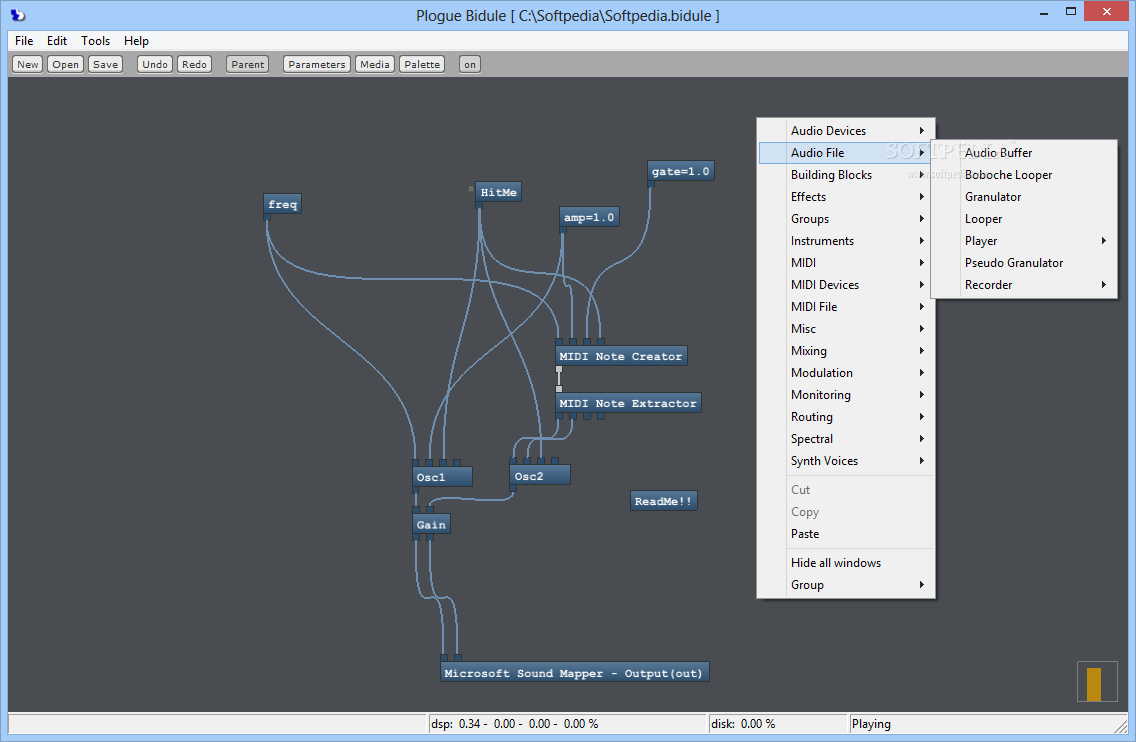
- #Plogue bidule slave Patch
- #Plogue bidule slave full
- #Plogue bidule slave software
- #Plogue bidule slave windows
#Plogue bidule slave Patch
All of the available objects for patch creation can be viewed by clicking on the Palette window shortcut button, located in the toolbar at the top of the workspace. Like Max/MSP, pd, and Reaktor, among others, you create patches by connecting these objects with patch chords. So, once it’s saved you could, hypothetically, have 512 inputs and 512 outputs for a single sub-patch!īidule’s graphical user interface has one main window, the patch bay, and uses the object-oriented paradigm (see Figure 1). Upon saving a sub-patch, you have the option to add up to 128 inputs and 128 outputs for each of the different signals (audio, MIDI, frequency, amplitude). This is especially useful if you find yourself turning to the same set of objects time after time. Like any object within Bidule, these building-block objects can be used to create sub-patches that can be saved for repeated use within other instruments, effects, or your own patches. These include Math functions (accum, binary/logic operator, counter, lookup table, value list, etc.), FFT using the phase-vocoder, Band-limited Oscillators, FIR, Envelopes, Delay line, and more. If you already have some understanding of modular environments and signal processing you might want to head directly to the Building Block objects. Some of the more interesting MIDI objects include the Stochastic MIDI Note, Stochastic MIDI List, Stochastic MIDI Sequencer, Note Shuffler, and the nifty Particle Arpeggiator. There are also many MIDI Filters, Remappers, and Transposers. These include phase distortion, pulse, noise, PWM oscillators, ADSR, AHDSR, synced graphical envelopes, and all-pass, bi-quad, comb, and FIR filters.īidule comes with an extensive array of pre-built MIDI objects to use in conjunction with its sound generators such as the 16 Step Sequencer, Buffer, Arpeggiator, CC to Params, MIDI to Value, Note Velocity to Params, Note Number to Params, and a MIDI Looper, Player, and Recorder. Along with the pre-built ChebyShev Waveshaper, SimpleFM, and CombTone sound generators, Bidule also provides users with the basic tools needed to build their own synthesizers. Among them are a Step Sequencer, Loop Player, Audio Buffer, Pseudo-granulator, 7 Drawbar Organ, Analog Drum Kit and PWMPolysynth, 4 Tap Delay, Buffer Granulator, TwoBandDistortion, Time Domain Convolver, Flanger, Freeverb, and a MoogVCF.
#Plogue bidule slave software
The software does require a video card with good OpenGL support.īidule comes with many pre-built instruments, effects, and utilities for musical creation. On Windows, Bidule can use ASIO, DirectSound, or MM drivers. Sampling rates are only limited by your audio drivers.
#Plogue bidule slave full
Bidule features full ASIO support for low-latency, 24-bit linear audio-file read/write, and a 32-bit floating point signal path. Bidule can also be inserted into any other VST host if you want to use it as an effect or instrument.
#Plogue bidule slave windows
It runs on both Windows and Macintosh operating systems as a standalone application, and can be used to host VST plugins. With Bidule, you have a collection of objects to create your own live/studio music-making environments. Marquette, Montreal, Quebec H2E 3B5, Canada electronic mail Web Reviewed by Jared Reganīidule, by Plogue, is real-time modular music software aimed mainly at audio artists seeking a new creative environment within which to experiment. I could slave Renoise to my Hardware sequencer and have Ableton slave to Renoise in perfect sync to play live sets without the need for any hardware midi clock and without the need to do any ms calculations.Bidule 0.92, US$ 75 Plogue Art et Technologie Inc., C.P. So if Renoise had Link and Ableton could slave to it, I would be in heaven.

Link is not all that great when it comes to syncing two different hardware devices since it doesn’t take hardware latency into account, but it can sync up playback of two apps and compensates for plugin latency one a single machine perfectly. When Ableton in Rewire Mode, it disables VSTs and syncing via a virtual Midi Port is not working because Renoise assumes that a Midi Port is going out of the machine and so will apply latency delay to the clock/notes (as it should!) The only problem is to now slave Ableton or another App/DAW to it. You can even slave it to a Hardware Drummachine and after hitting play it will correctly delay the incoming midi clock negatively to sync up after a few ms. Renoise is genius when it comes to interacting with Hardware. I’ve tested a lot of different combinations to sync hardware and software.


 0 kommentar(er)
0 kommentar(er)
